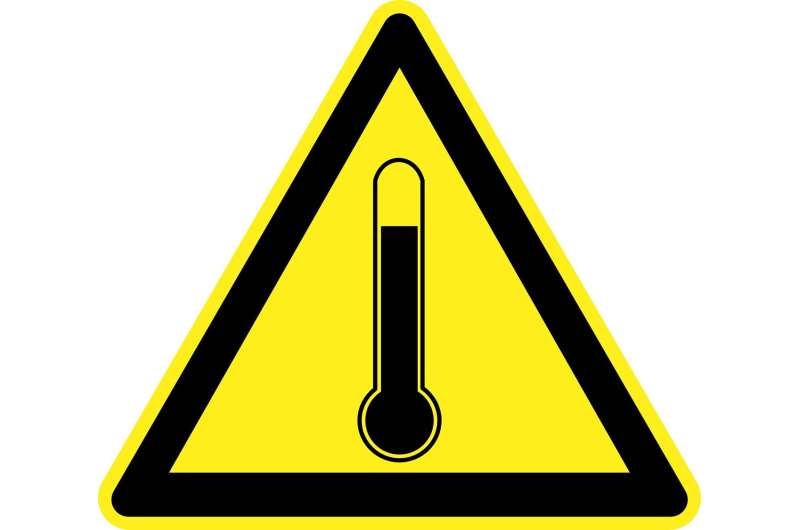This article has been reviewed according to Science X's editorial process and policies. Editors have highlighted the following attributes while ensuring the content's credibility:
fact-checked
peer-reviewed publication
trusted source
proofread
High temperatures may have caused over 70,000 excess deaths in Europe in 2022

The burden of heat-related mortality during the summer of 2022 in Europe may have exceeded 70,000 deaths according to a study led by the Barcelona Institute for Global Health (ISGlobal).
The authors of the study, published in The Lancet Regional Health—Europe, revised upwards initial estimates of the mortality associated with record temperatures in 2022 on the European continent. The study is titled "The effect of temporal data aggregation to assess the impact of changing temperatures in Europe: an epidemiological modelling study."
In an earlier study, published in Nature Medicine, the same team used epidemiological models applied to weekly temperature and mortality data in 823 regions in 35 European countries and estimated the number of heat-related premature deaths in 2022 to be 62,862.
In that study, the authors acknowledged that the use of weekly data would be expected to underestimate heat-related mortality, and pointed out that daily time-series data are required to accurately estimate the impact of high temperatures on mortality.
The objective of the new study was to develop a theoretical framework capable of quantifying the errors arising from the use of aggregated data, such as weekly and monthly temperature and mortality time-series. Models based on temporally aggregated data are useful because aggregated data are available in real-time from institutions such as Eurostat, facilitating quantification of the health hazard within a few days of its emergence.
To develop a theoretical framework, the research team aggregated daily temperatures and mortality records from 147 regions in 16 European countries. They then analyzed and compared the estimates of heat- and cold-related mortality by different levels of aggregation: daily, weekly, two-weekly and monthly.
Analysis revealed differences in epidemiological estimates according to the time scale of aggregation. In particular, it was found that weekly, two-weekly and monthly models underestimated the effects of heat and cold as compared to the daily model, and that the degree of underestimation increased with the length of the aggregation period.
Specifically, for the period 1998–2004, the daily model estimated an annual cold and heat-related mortality of 290,104 and 39,434 premature deaths, respectively, while the weekly model underestimated these numbers by 8.56% and 21.56%, respectively.
"It is important to note that the differences were very small during periods of extreme cold and heat, such as the summer of 2003, when the underestimation by the weekly data model was only 4.62%," explains Joan Ballester Claramunt, the ISGlobal researcher who leads the European Research Council's EARLY-ADAPT project.
The team used this theoretical framework to revise the mortality burden attributed to the record temperatures experienced in 2022 in their earlier study. According to the calculations made using the new methodological approach, that study underestimated the heat-related mortality by 10.28%, which would mean that the actual heat-related mortality burden in 2022, estimated using the daily data model, was 70,066 deaths, and not 62,862 deaths as originally estimated.
Using weekly data to analyze the effects of temperatures in the short term
"In general, we do not find models based on monthly aggregated data useful for estimating the short-term effects of ambient temperatures," explains Ballester.
"However, models based on weekly data do offer sufficient precision in mortality estimates to be useful in real-time practice in epidemiological surveillance and to inform public policies such as, for example, the activation of emergency plans for reducing the impact of heat waves and cold spells."
It is an advantage in this area of research to be able to use weekly data since investigators often encounter bureaucratic obstacles that make it difficult or impossible to design large-scale epidemiological studies based on daily data.
According to Ballester, when daily data is not available, the use of weekly data, which are easily accessible for Europe in real-time, is a solution that can offer "a good approximation of the estimates obtained using the daily data model".
More information: Ballester J et al, The effect of temporal data aggregation to assess the impact of changing temperatures in Europe: an epidemiological modelling study, The Lancet Regional Health—Europe (2023). DOI: 10.1016/j.lanepe.2023.100779
Journal information: Nature Medicine
Provided by Barcelona Institute for Global Health





















